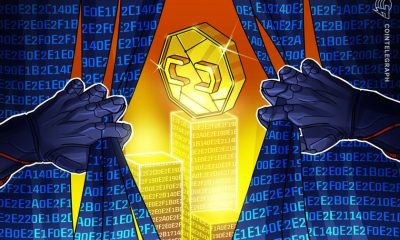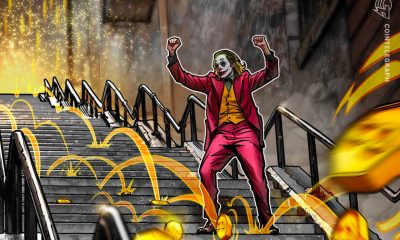Blockchain
The Four Phases of Decentralized Finance

The DeFi industry has been growing and changing — here are the four-phase model that clarifies what has been achieved and what to expect in the future
Newcomers to decentralized finance, or DeFi, would be hard-pressed to believe how much the industry has grown, changed and matured in just over a year. At the end of 2018, Maker returned to the scene with relaunched tooling and a buzzy investment from the experts at Andreessen Horowitz. Compound Finance launched around the same time, offering money markets for Ethereum-based assets and has also received funds from Andreessen Horowitz, which invested more in Compound at the end of 2019.
Although the DeFi industry has moved at a remarkable speed, it’s still possible to make simple sense of the industry. I find that a four-phase model helps define the major changes already accomplished and the radical developments still to come. There are no hard-and-fast divisions between these phases; one company or market may enter a new stage while others languish in the previous phase. The DeFi industry, after all, has never operated in lockstep.
Related: Decentralized Finance, Explained
The first phase
The first phase could be called the “Big Bang.” Entrepreneurs, analysts and specialists recognized that traditional financial products could be ported to blockchains and distributed ledgers.
Unfortunately, the Big Bang turned out to be something of a Slow Burn: These first products showed skeptics that blockchains can handle complicated financial instruments, but their speed left something to be desired. They were successful proof-of-concept protocols, but not wholly satisfying products.
Some “Big Bang” products include Maker and Compound, which enabled overcollateralization for loans and borrowing. This first phase, though it moved more quickly, resembles the mid-90s’ web boom: Products like email and primitive search replicated analog services like the post office and the yellow pages, but they were slow, clunky and difficult to manage.
The second phase
After the initial proof-of-concept phase, DeFi entered a breakout moment — the second phase. Experts realized that crypto-native financial products were possible, and that decentralization was an advantage rather than a liability. Decentralized takes on preexisting products showed that a token value-capture mechanism could thrive, and we witnessed the rise of synthetic assets and decentralized exchanges for spot and derivatives markets.
The 90s internet equivalent might correspond to the rise of companies like Yahoo! and Netscape, which provided native applications for web users, not just replications of preexisting analog tools. It’s perhaps worth noting that Netscape co-founder Marc Andreessen is also a principal of Andreessen Horowitz.
The third phase
In the industry’s first phase, DeFi innovators attempted to move traditional financial products onto the blockchain, but their efforts were stymied by slow operation and processing speeds. In the third phase of DeFi, firms returned to traditional products.
Exponential advantages accrued to “traditional” products that exploited the potential of decentralization while the limits of previous chains and ledgers are surpassed. Regulatory, user experience and scaling solutions remove barriers to entry while consumer-scale products become inevitable.
Under-collateralization, consumer insurance and invoice factoring are potential products for DeFi at this level of development. Many firms and projects are already in the early portions of DeFi’s third phase, while others are about to enter it. If we continue to extend the internet analogy, this phase might correspond to the meteoric rises of Amazon and EBay — two companies that persuaded a doubting public that online commerce could transform their lives.
The fourth phase
The fourth and final phase of DeFi is, almost by definition, the most speculative: We don’t quite know when it will arrive, and we don’t know quite what it will contain. The fourth phase will introduce concepts and products that we can’t yet imagine, but which will likely seem obvious in retrospect.
To take a recent example, the development and democratization of digital photography accelerated the explosive growth of social media, an industry tangentially linked to classified ads and phone directories but more engaging, more entertaining and more lucrative.
Facebook and Twitter enabled new forms of human connection. Just 20 years ago, social media was almost inconceivable, yet now it seems like a basic part of life — the youngest workers today have no memories of life before social media. The fourth phase of DeFi might have a similar effect on our financial lives. Just how, we will wonder, did we get by without these products and services?
The future looks bright for decentralized finance, and if past lessons are any indication, that future may arrive sooner than any of us expect. The internet took decades to get from ARPANET prototypes to college-campus curiosity to commercially available products. Subsequent steps were much quicker, and DeFi may experience similar acceleration. Many major projects in DeFi remain in the sector’s second stage, a few have achieved the third phase, and a few more remain in the initial phase.
In the year to come, I believe we will see many more companies, projects and innovations appear. I expect third-stage companies to multiply quickly, and who knows — perhaps before the year is out, we will recognize the first final-stage decentralized finance applications. The world is ready and we’re all waiting.
The views, thoughts and opinions expressed here are the author’s alone and do not necessarily reflect or represent the views and opinions of Cointelegraph.
Michael Anderson is the co-founder and partner at Framework Ventures, a venture capital firm focused on building the value of blockchain networks through strategic investment and infrastructural support. Before founding Framework, Michael built and sold Hashletes, the first and only NFLPA-licensed digital collectibles, with co-founder Vance Spencer. Michael’s prior experience bridges investment banking and consumer tech, with experience from Snap, Inc., Dropbox and Barclays Capital.

















